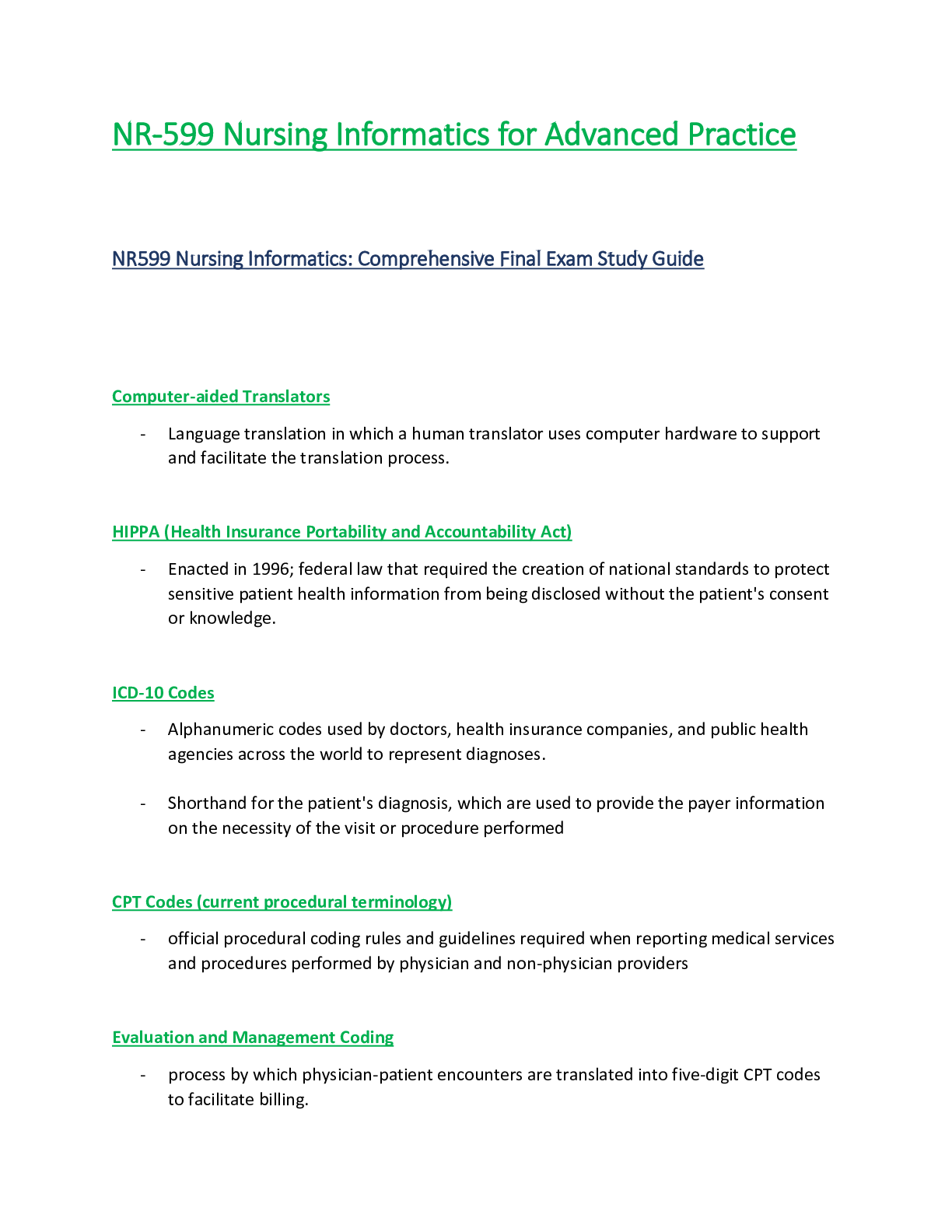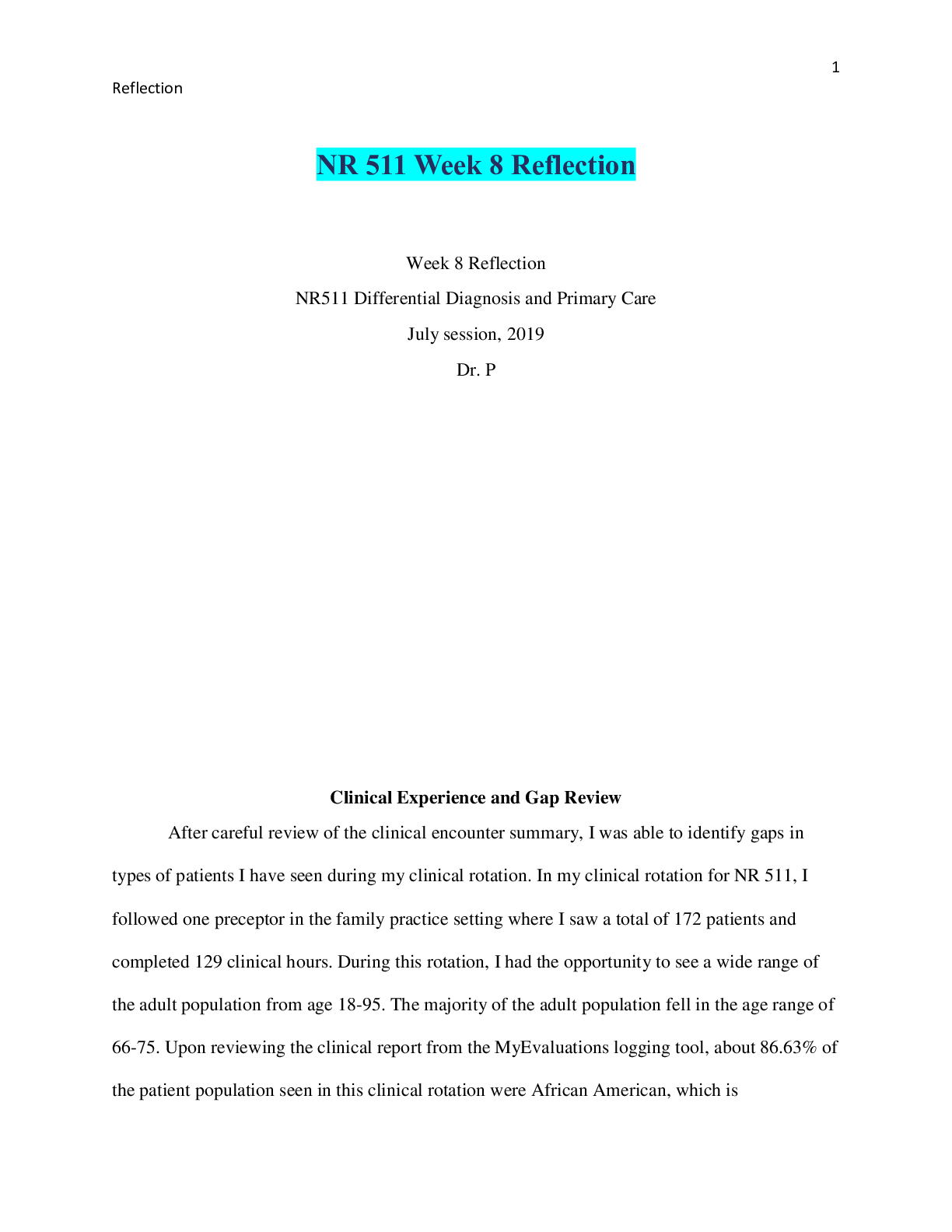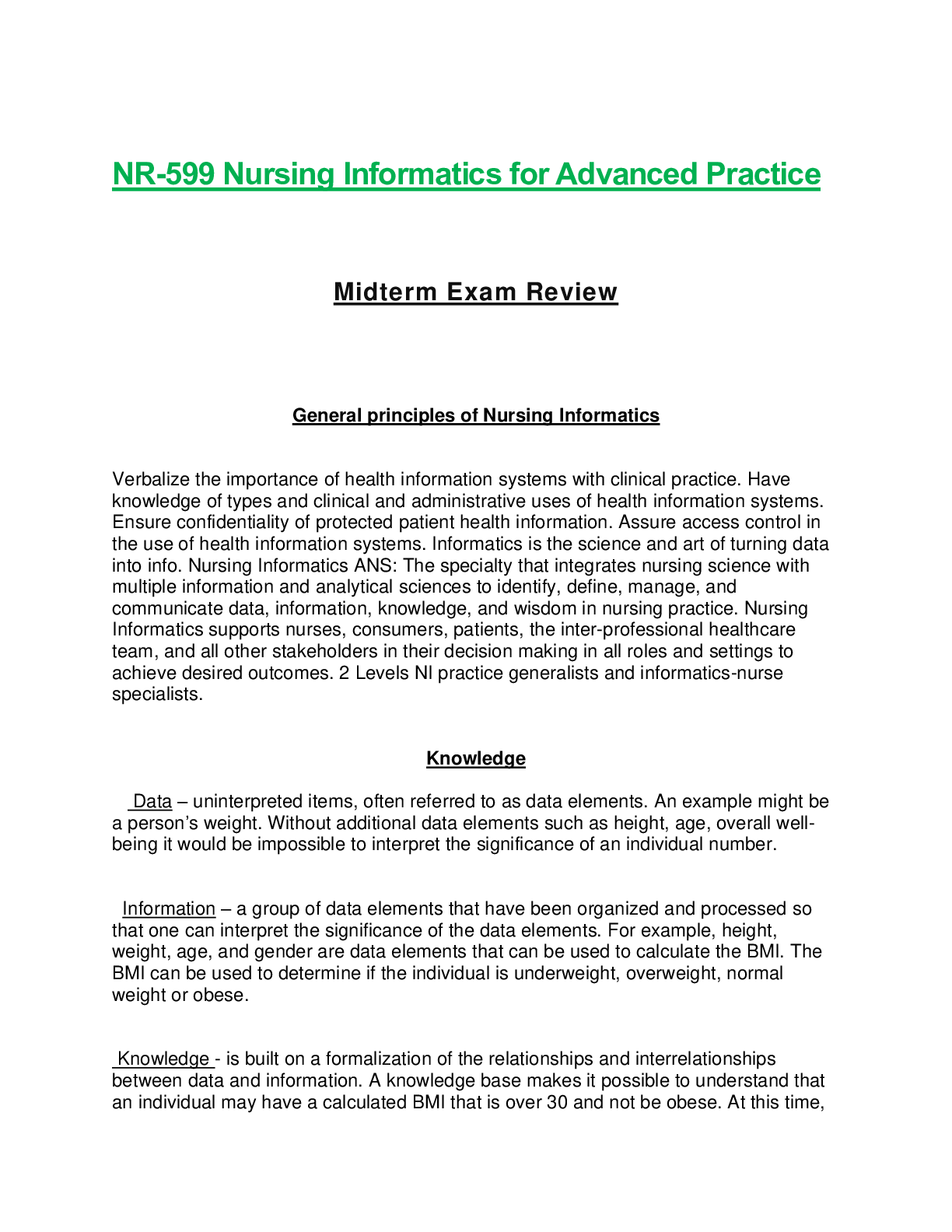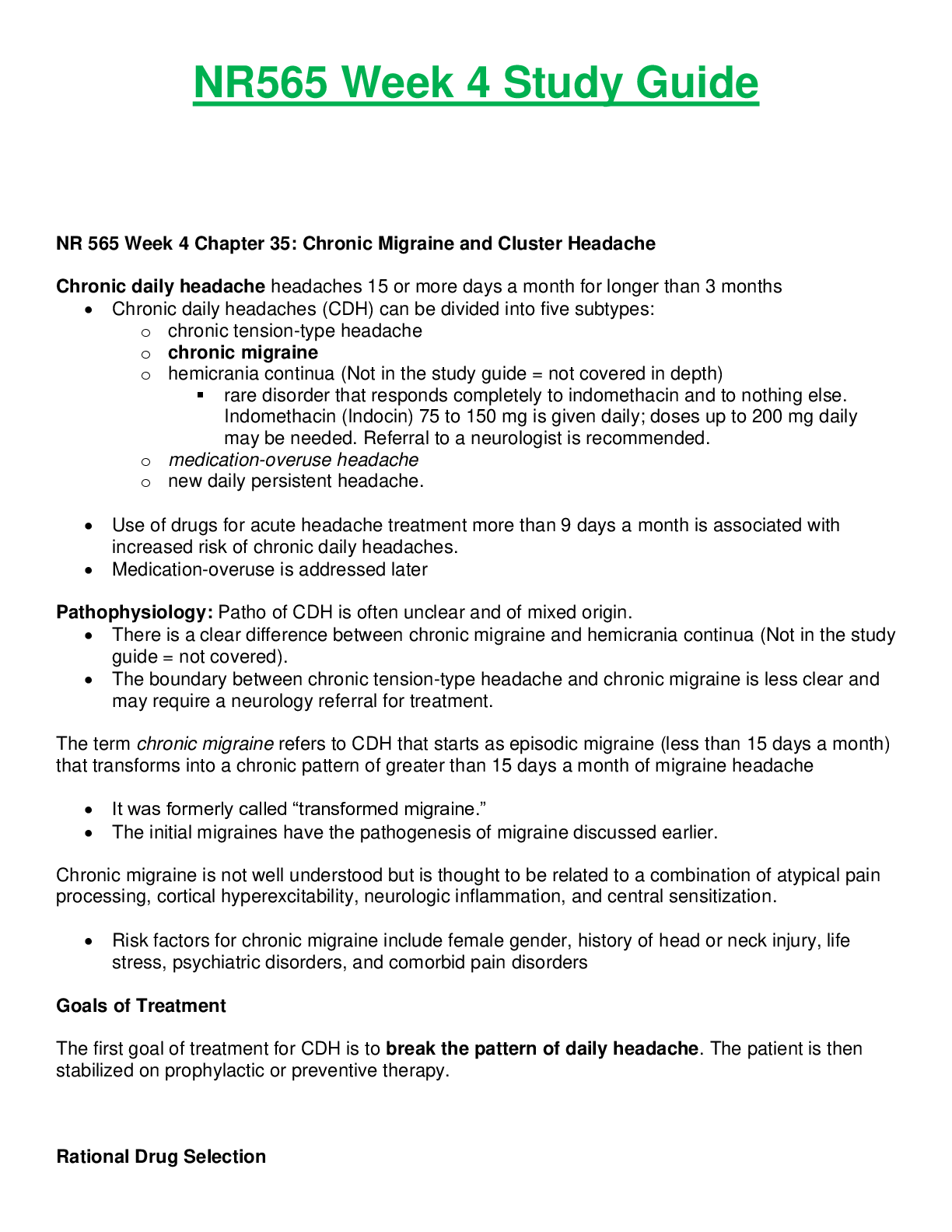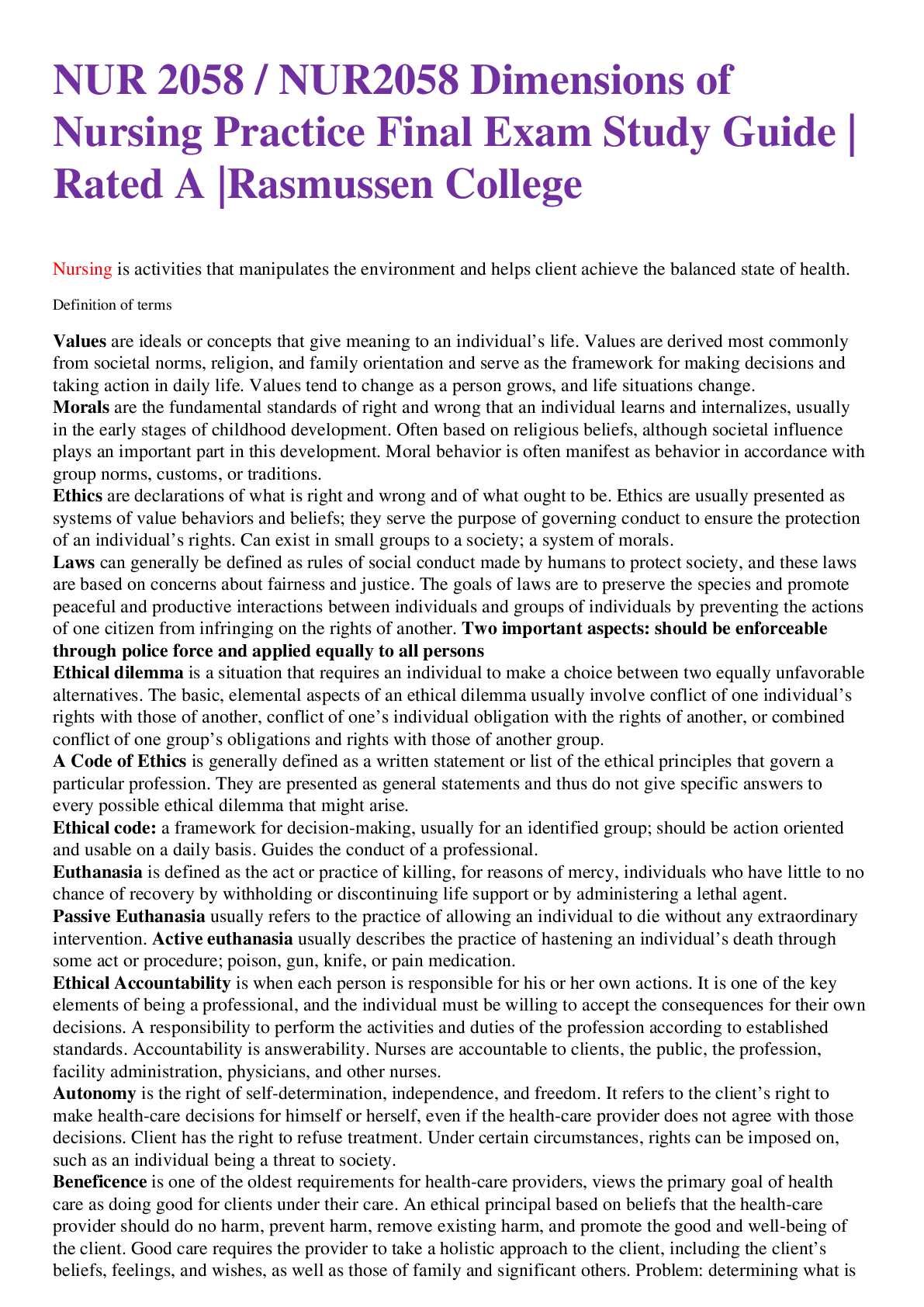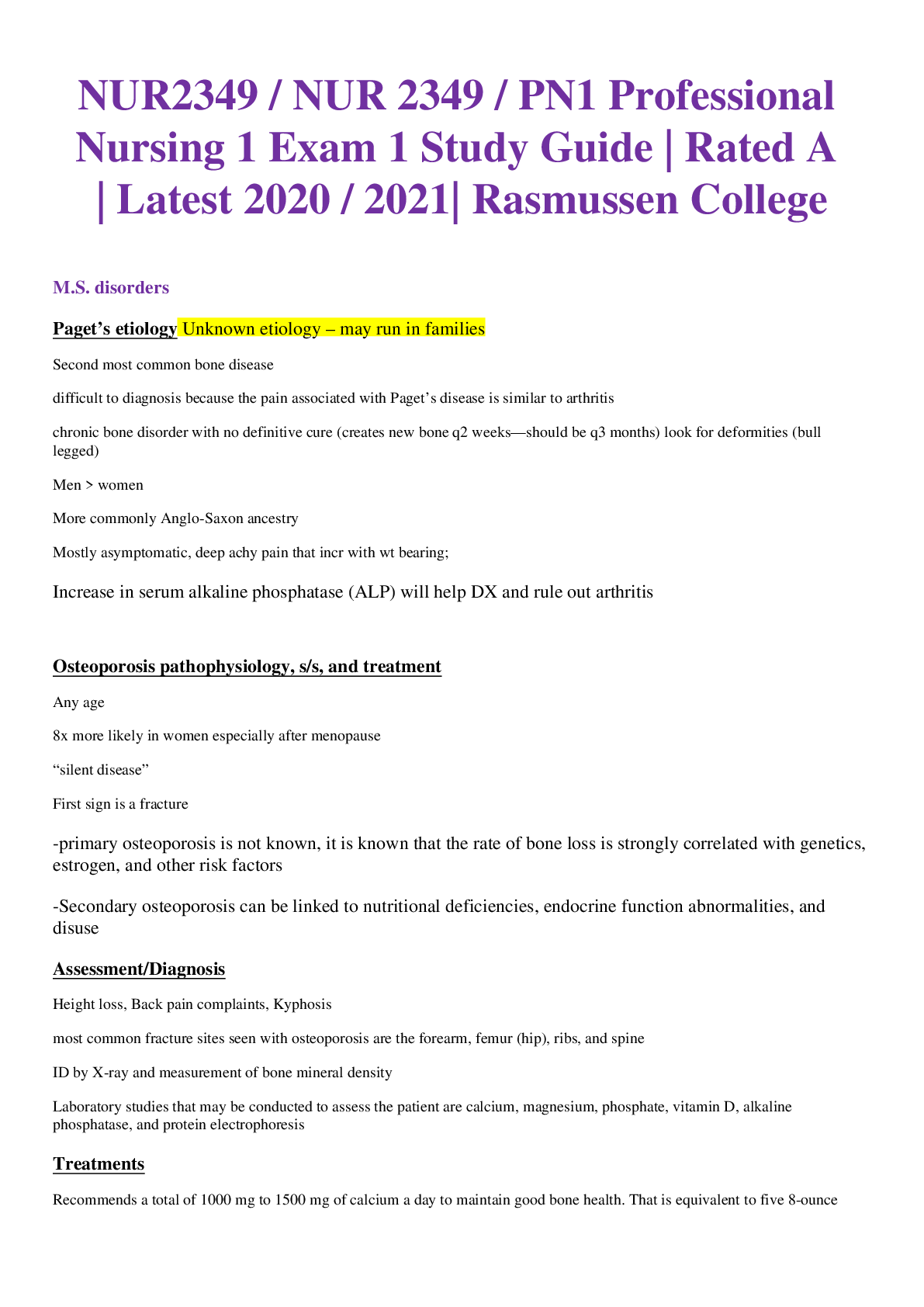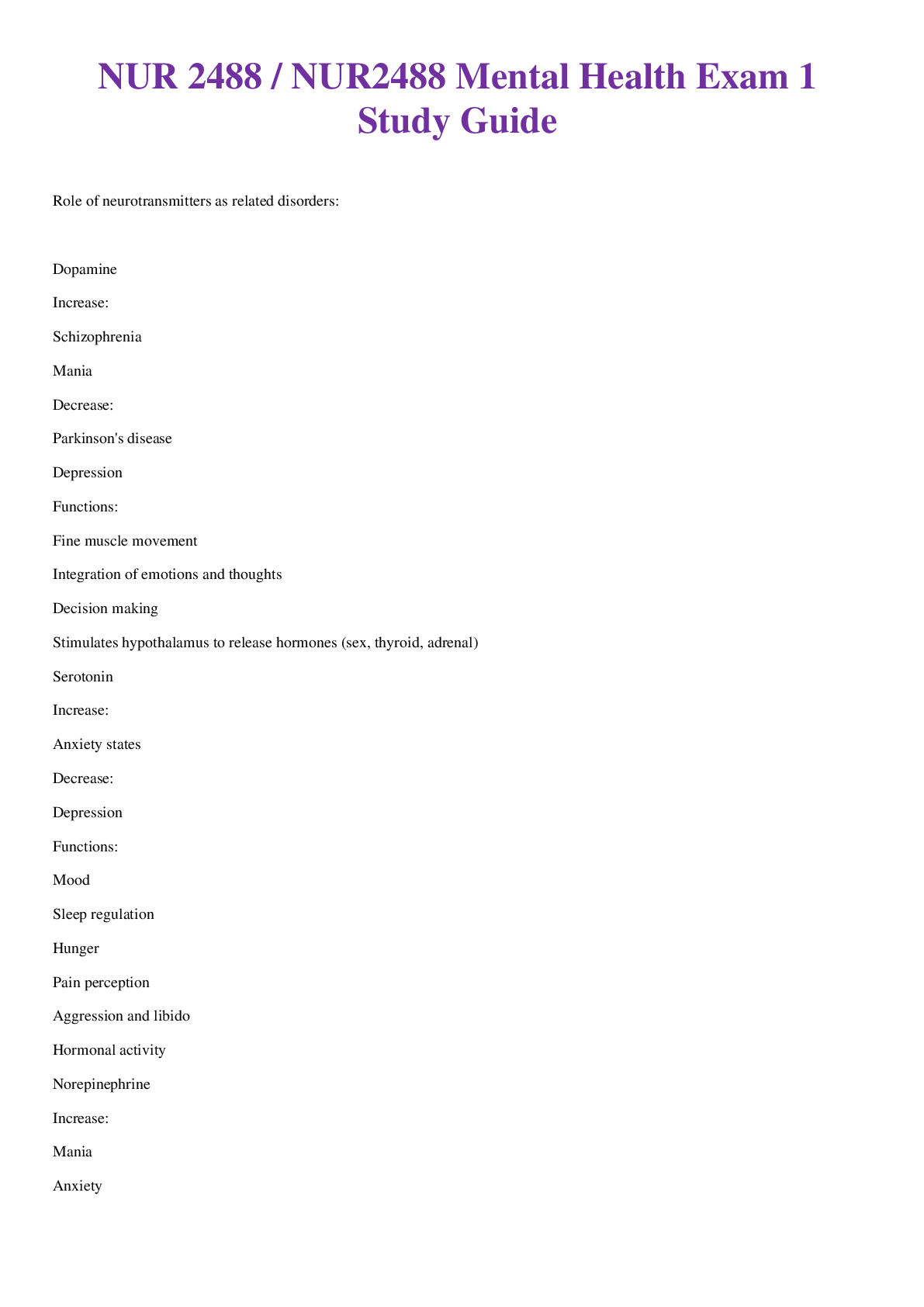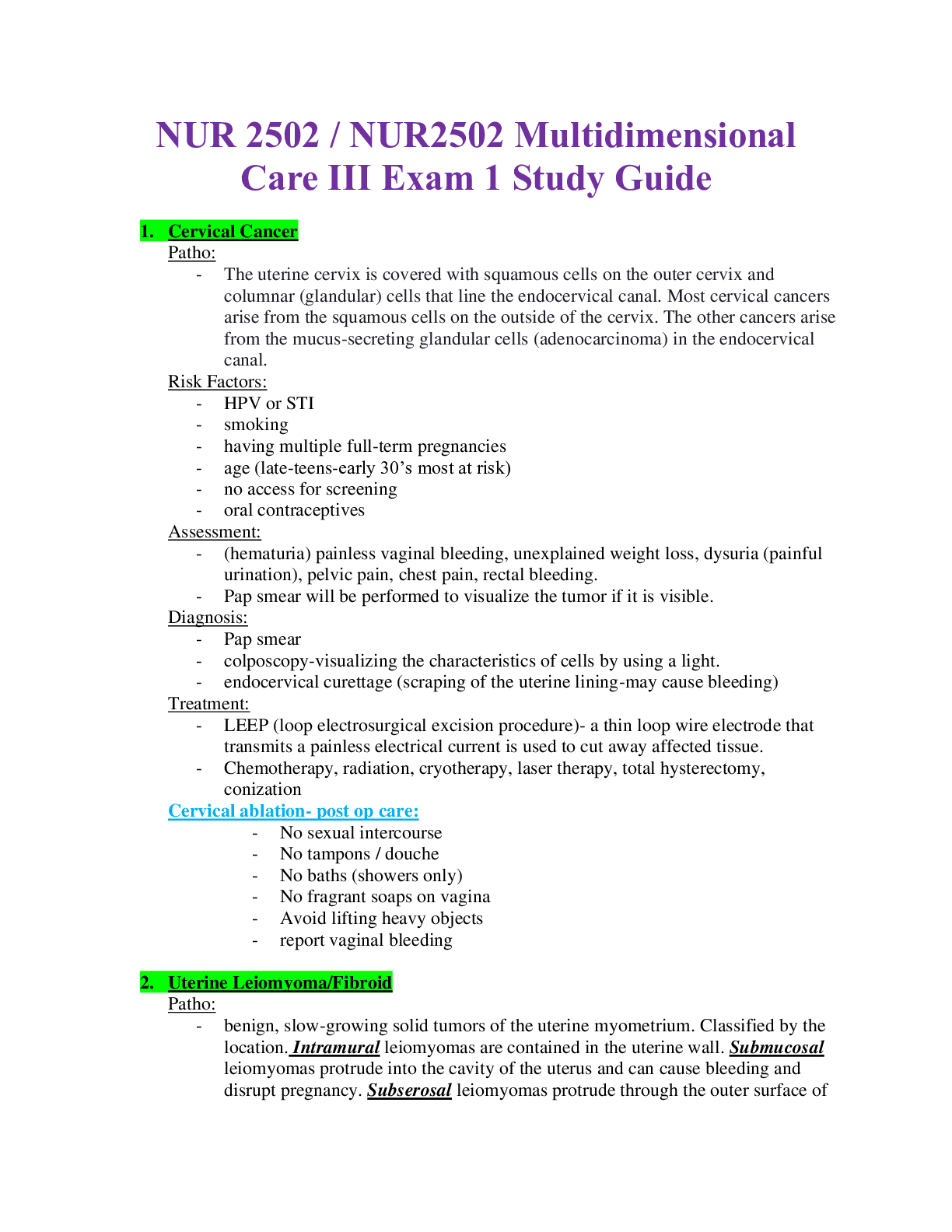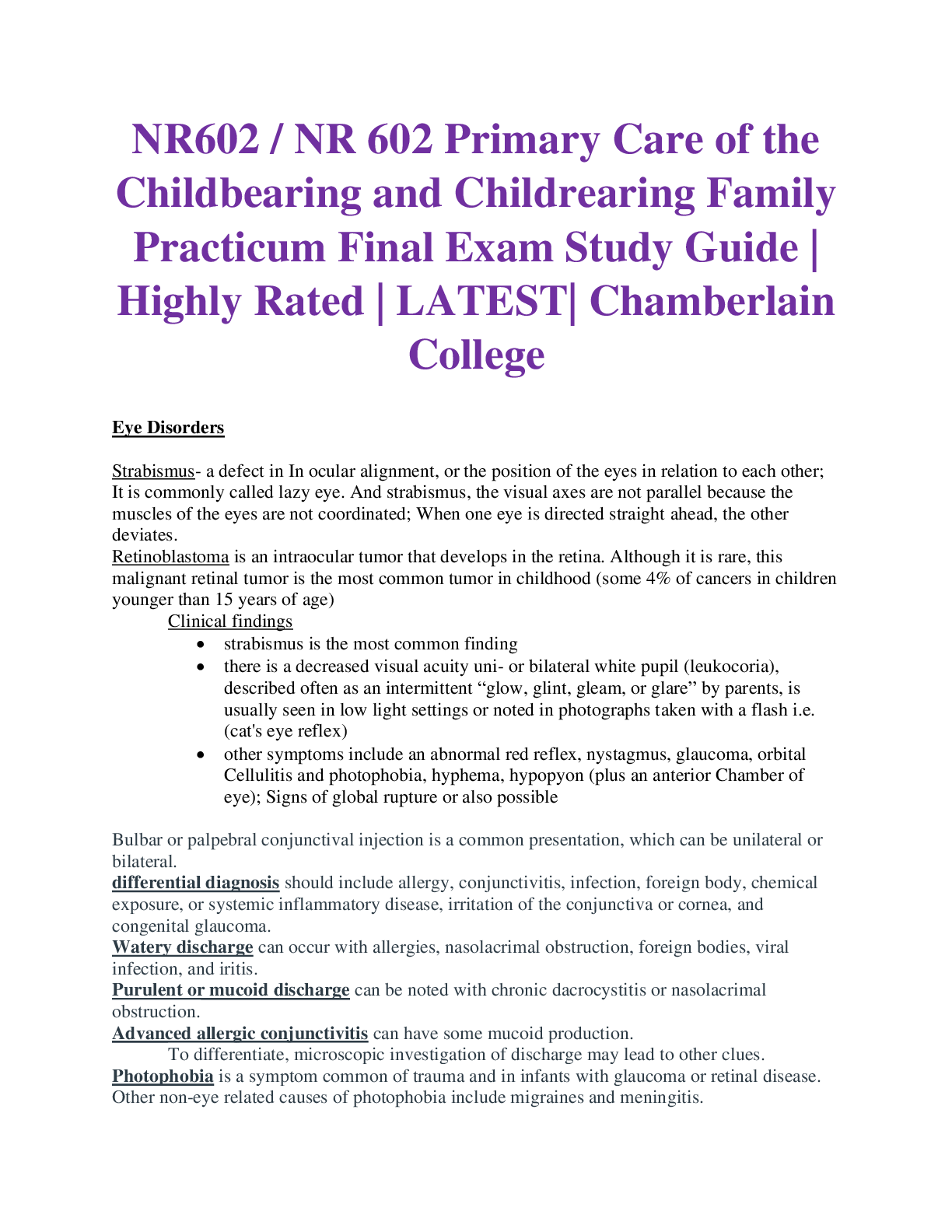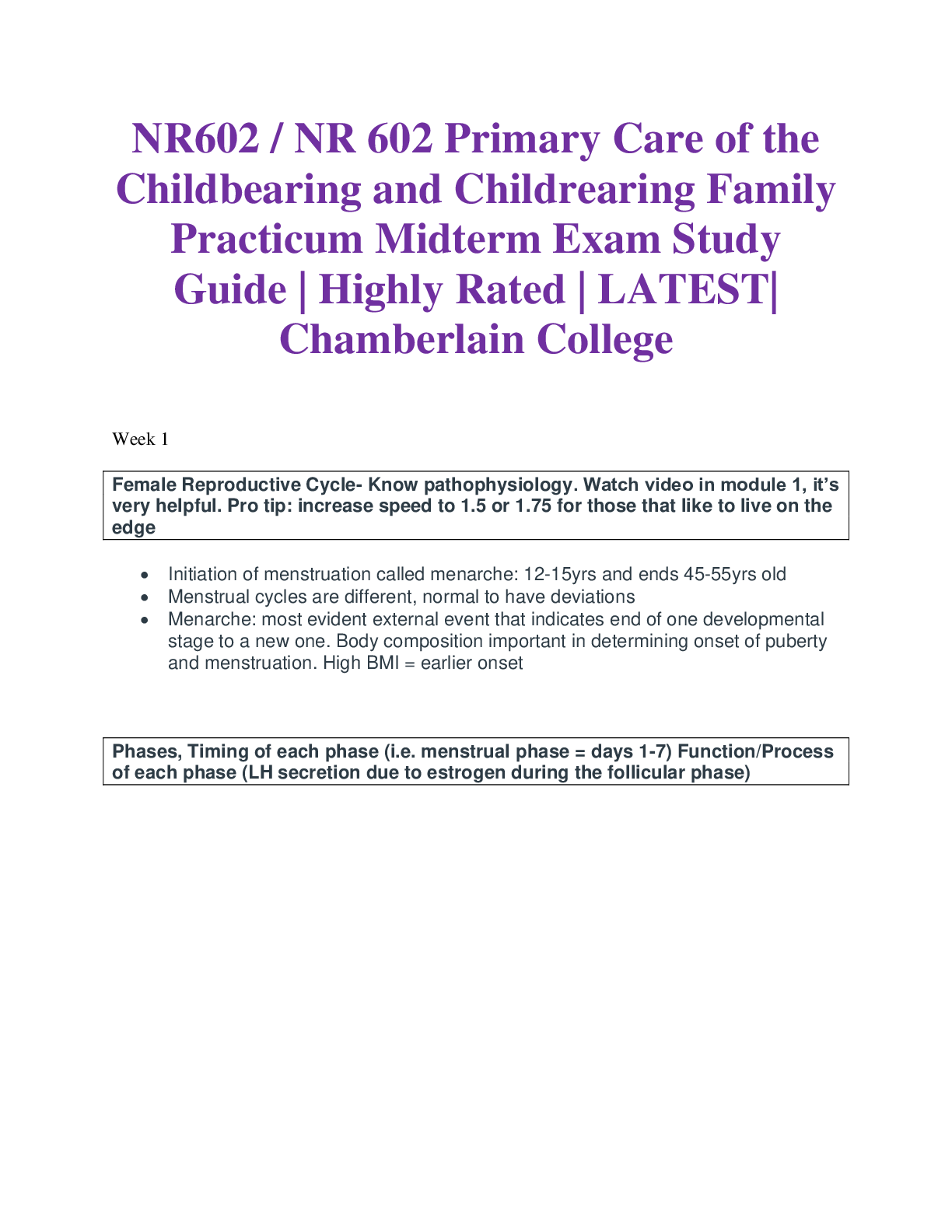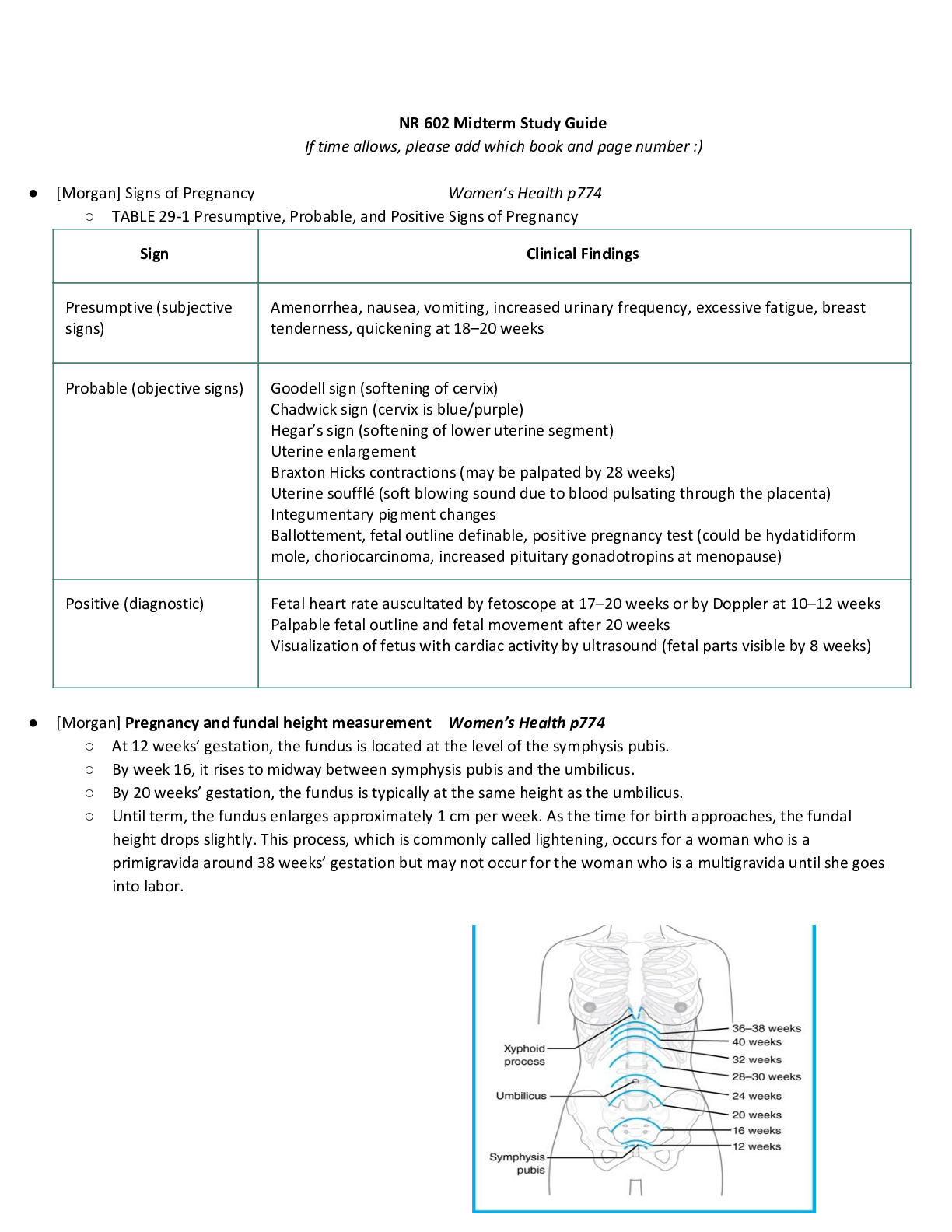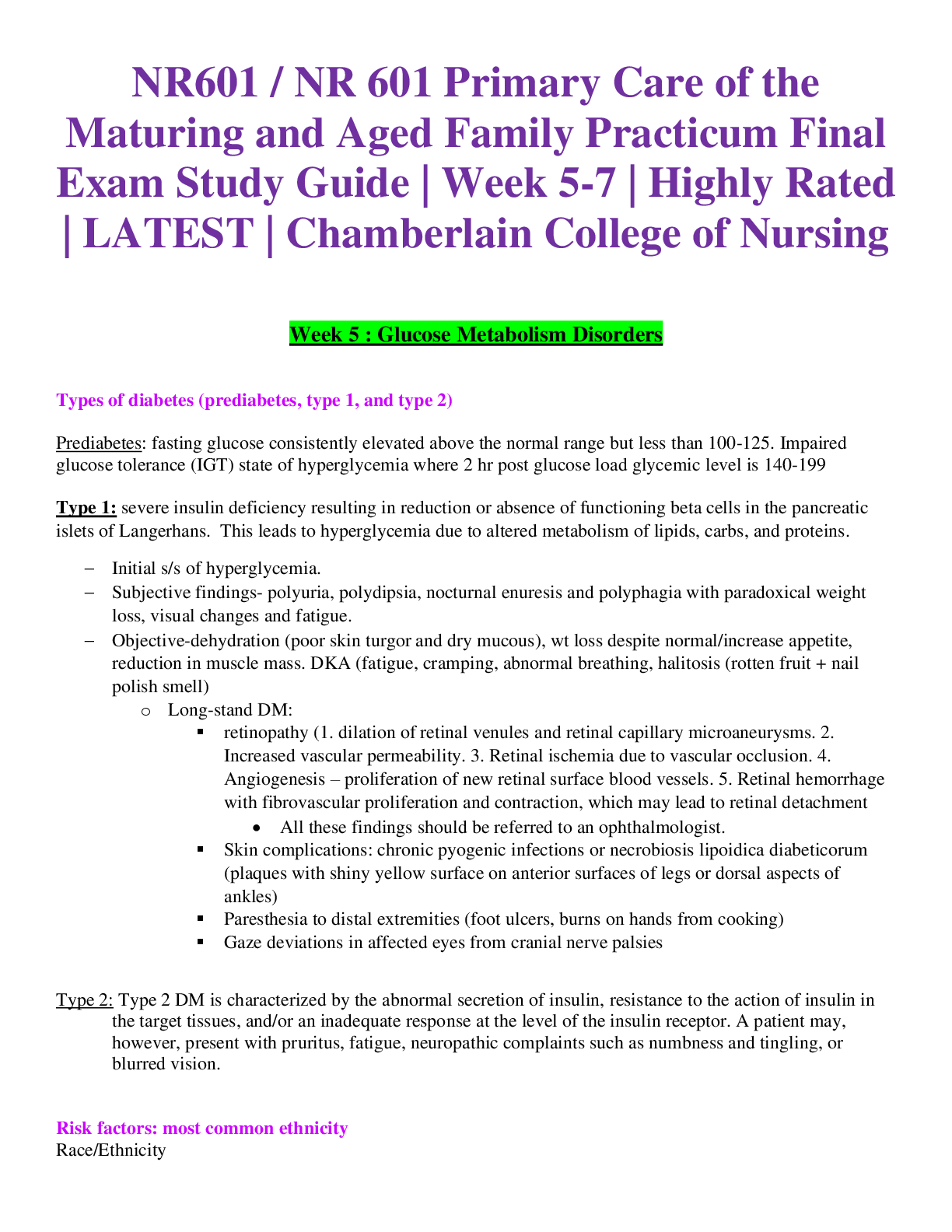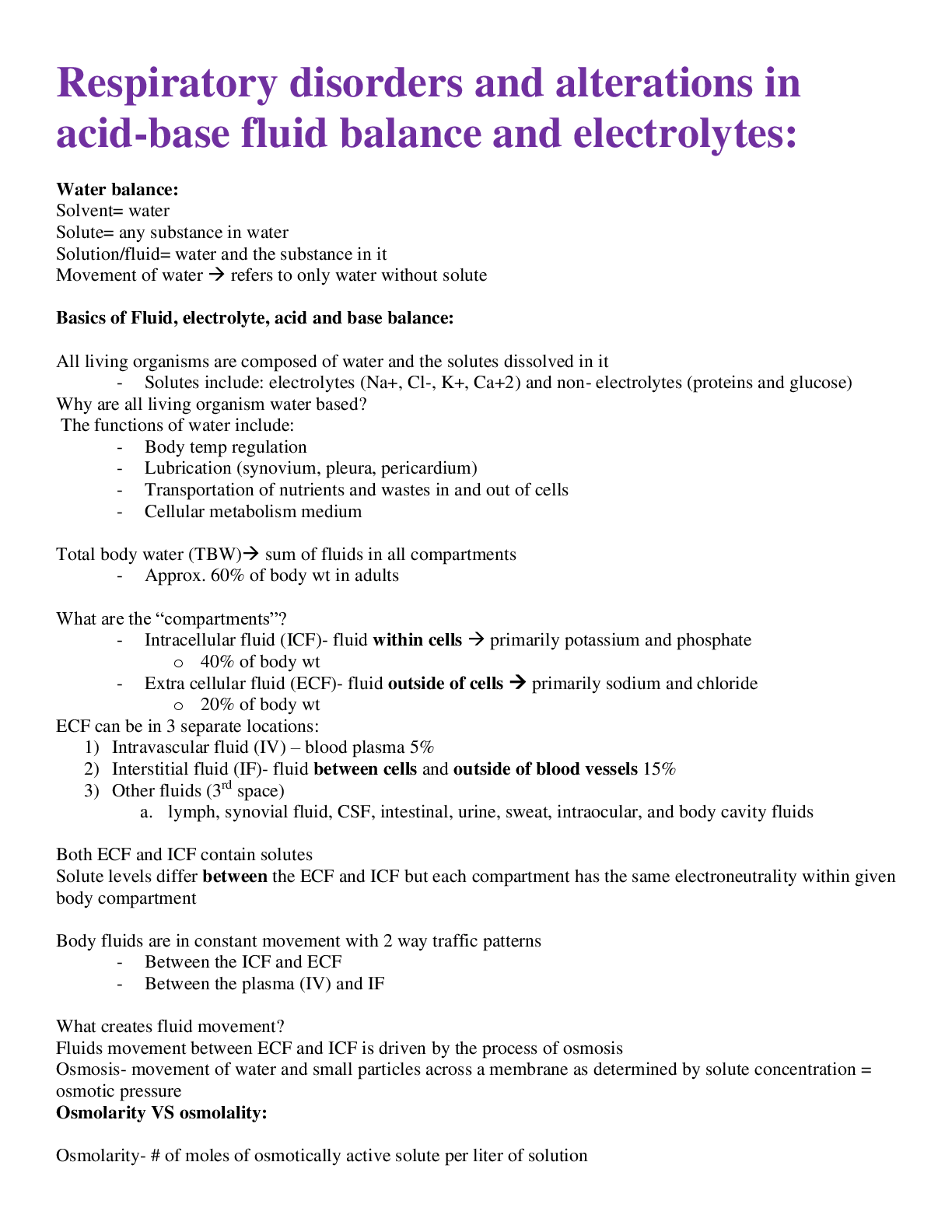*NURSING > STUDY GUIDE > NR 511 FINAL EXAM STUDY GUIDE (VERSION 2) / NR511 WEEK 8 FINAL EXAM STUDY GUIDE | LATEST-2021 |: DIF (All)
NR 511 FINAL EXAM STUDY GUIDE (VERSION 2) / NR511 WEEK 8 FINAL EXAM STUDY GUIDE | LATEST-2021 |: DIFFERENTIAL DIAGNOSIS AND PRIMARY CARE PRACTICUM: CHAMBERLAIN COLLEGE OF NURSING |100% CORRECT ANSWERS, DOWNLOAD TO SCORE A|
Document Content and Description Below
NR 511 FINAL EXAM STUDY GUIDE (VERSION 2) / NR511 WEEK 8 FINAL EXAM STUDY GUIDE | LATEST-2021 |: DIFFERENTIAL DIAGNOSIS AND PRIMARY CARE PRACTICUM: CHAMBERLAIN COLLEGE OF NURSING |100% CORRECT ANSWERS... , DOWNLOAD TO SCORE A| Define diagnostic reasoning Discuss and identify subjective data? Discuss-and identify objective data? Discuss and identify the components of the HPI What is medical coding? What-is medical billing? What are CPT codes? What-are ICD codes? What is specificity? What-is sensitivity? What is predictive value? Discuss the elements that need to be considered when developing a plan Describe the components of Medical Decision Making in E&M coding Correctly order the E&M office visit codes based on complexity from least to most complex Discuss a minimum of three purposes of the written history and physical in relation to the importance of documentation Accurately document why every procedure code must have a corresponding diagnosis code Correctly identify a patient as new or established given the historical information Identify the 3 components required in determining an outpatient, office visit E&M code Describe the components of Medical Decision Making in E&M coding Explain what a “well rounded” clinical experience means What is the first “S” in the SNAPPS presentation? What is the “N” in the SNAPPS presentation? State the maximum number of hours that time can be spent “rounding” in a facility What is the “A” in the SNAPPS presentation? What is the first “P” in the SNAPPS presentation? State 9 things that must be documented when inputting data into clinical encounter What is the second “P” in the SNAPPS presentation? What is the last “S” in the SNAPPS presentation? NR 511 WEEK 2 What is the most common type of pathogen responsible for acute gastroenteritis? Assessing for prior antibiotic use is a critical part of the history in patients presenting with diarrhea. Describe the difference between Irritable Bowel Disease (IBS) and Inflammatory Bowel Disorder (IBD) Discuss two common Inflammatory Bowel Diseases Discuss the diagnosis of diverticulitis, risk factors, and treatments Identify the significance of Barrett’s esophagus. What is best test for diagnosing GERD? Risk factors of GERD: How do we treat suspected GERD in patients with classic symptoms? How do we treat suspected GERD in patients with “alarm symptoms”? What are “alarm symptoms” for patients with suspected GERD? Clinical characteristics of GERD: Discuss the differential diagnosis of acute abdominal pain, work-up and testing, treatments Discuss the difference between sensorineural and conductive hearing loss Identify the triad of symptoms associated with Meniere’s disease Identify the symptoms associated with peritonsillarabscess Identify-the most common cause of viral pharyngitis Identify the most common cause of acute nausea & vomiting What is the importance of obtaining an abdominal XR to rule out perforation or obstruction even though the diagnosis of diverticulitis can be made clinically? What are colon cancer screening recommendations relative to certain populations? Identify at least two disorders that are considered to be disorders related to conductive hearing loss. What is the most common cause of bacterial pharyngitis? What-are the clinical findings associated with mononucleosis? What are common characteristics in a rash caused by Group A Strep? How is the diagnosis of streptococcal pharyngitis made clinically based on the Centor Criteria? What is one intervention for a patient with gastroenteritis? What is an appropriate treatment for prophylaxis or treatment of traveler’s diarrhea? What-is at least one effective treatment for IBS? What is at least one prescription med used to treat chronic constipation? What-is at least one treatment for Meniere’s disease? NR 511 WEEK 3 The majority of dyspnea complaints are due to cardiac or pulmonary decompensation? What are the differences between intra-thorax and extra-thorax flow disorders What are at least three examples of flow and volume disorders (intra and/or extra thorax)? Describe classes of asthma? What are the different treatments for the asthma classes? Identify respiratory characteristics of asthma: What are treatment options for asthma? What-are appropriate tests in the work-up for dyspnea? What is Asthma? Why are there two peaks in prevalence of asthma? What would you anticipate to happen in between asthma attacks? How do you monitor asthma? What is the non-pharmacological treatment for asthma? What is COPD? Describe the clinical presentation of COPD Describe the differences between pink puffers and blue bloater What will an X-ray of a patient with COPD show? Describe the medication routes in the treatment of COPD Compare and contrast asthma and COPD Differentiate between rubeola, rubella, varicella, roseola, 5ths disease, pityriasis rosea, hand/foot/mouth, and molluscum contagiosum. Differentiate between tinea pedis, cruris, corporis, and unguium. What are the appropriate treatments for each? Identify the virus that causes warts Differentiate between atopic and contact dermatitis and give examples of each. Identify common characteristics associated with blepharitis, chalazion and hordeolum What are the risk factors for diabetic retinopathy? What are the manifestations of diabetic retinopathy? Differentiate between viral, allergic, bacterial, toxic and HSV conjunctivitis Which chemical injury is associated with the most damage and highest risk to vision loss? What are common eye emergency conditions that require emergency room eval? Discuss glaucoma, diagnosis and treatment What is diabetic retinopathy? what are the causes of diabetic retinopathy How is diabetic retinopathy diagnosed? What are nursing implications/ND for clients with diabetic retinopathy? How is diabetic retinopathy managed/goal of treatment? What are the surgeries for diabetic retinopathy: What assessment data would the nurse gather for someone with diabetic retinopathy? NR 511 WEEK 5 Identify the population most commonly affected by bacterial prostatitis Discuss the physical exam characteristics of acute bacterial prostatitis Discuss how the Phren sign can differentiate between testicular torsion and epididymitis Identify the population most affected by testicular cancer nr 511 final exam Discuss common symptoms reported from a patient with BPH Discuss the hallmark characteristic of a varicocele Explain spinal stenosis nr 511 final exam Discuss common characteristics (subjective and objective findings) of patients with lumbar spinal stenosis Identify the red flags associated with back and neck complaints which warrant further investigation Define chronic pain Identify the number of joints involved in a poly-articular disorder Describe the four cardinal signs of joint inflammation nr 511 final exam Differentiate between DeQuervain’s Tenosynovitis and Carpal Tunnel Syndrome Differentiate between lateral and medial epicondylitis Discuss at least 3 vital body functions which thyroid hormones regulate Describe a goiter and the type of thyroid dysfunction that can be associated with it Differentiate between overt hypothyroidism and subclinical hypothyroidism Differentiate between Hashimoto’s thyroiditis and Grave’s disease Identify at least 3 risks associated with obesity Identify at least 3 causes of obesity Discuss one primary prevention for obesity nr 511 final exam Identify the categories of obesity based on the BMI Discuss how acute low back pain without neurological dysfunction does not warrant radiological imaging Identify the roles of TSH, FT4, TT3, and TPO Abs in determining thyroid function Identify at least one “at-risk” population who should be considered for thyroid screening Discuss one physical characteristic seen in a hyperthyroid patient nr 511 final exam Identify the CDC recommended antibiotic class for treatment of acute bacterial prostatitis Identify-at least one treatment for BPH Identify treatment options for obesity based on BMI and comorbid condition Describe the Spurling test and what condition it is used to diagnose Describe how to perform a Phalen and Tinnel test Identify at least 3 physical exam maneuvers to assess the knee NR 511 WEEK 6 FINAL EXAM Differentiate between resting, postural and intention tremors and describe each Describe one disease with resting tremor as a clinical finding Describe a medication commonly associated with tremors Identify at least 3 laboratory tests to rule out systemic causes of tremor Describe at least one at-risk population that is recommended to have HIV screening Describe-at least one pharmacologic treatment option for tremor Describe an appropriate empiric antibiotic treatment plan for cellulitis Discuss an intervention to prevent HIV and HIV-associated behaviors Identify physical exam findings in the patient with HIV nr 511 final exam Describe symptoms, DDx, pathogens, testing, and treatment for the following conditions: Cellulitis, impetigo, MRSA, Bites (dogs, cats, humans), Erysipelas [Show More]
Last updated: 1 year ago
Preview 1 out of 48 pages
Reviews( 0 )
Document information
Connected school, study & course
About the document
Uploaded On
Dec 27, 2020
Number of pages
48
Written in
Additional information
This document has been written for:
Uploaded
Dec 27, 2020
Downloads
0
Views
46

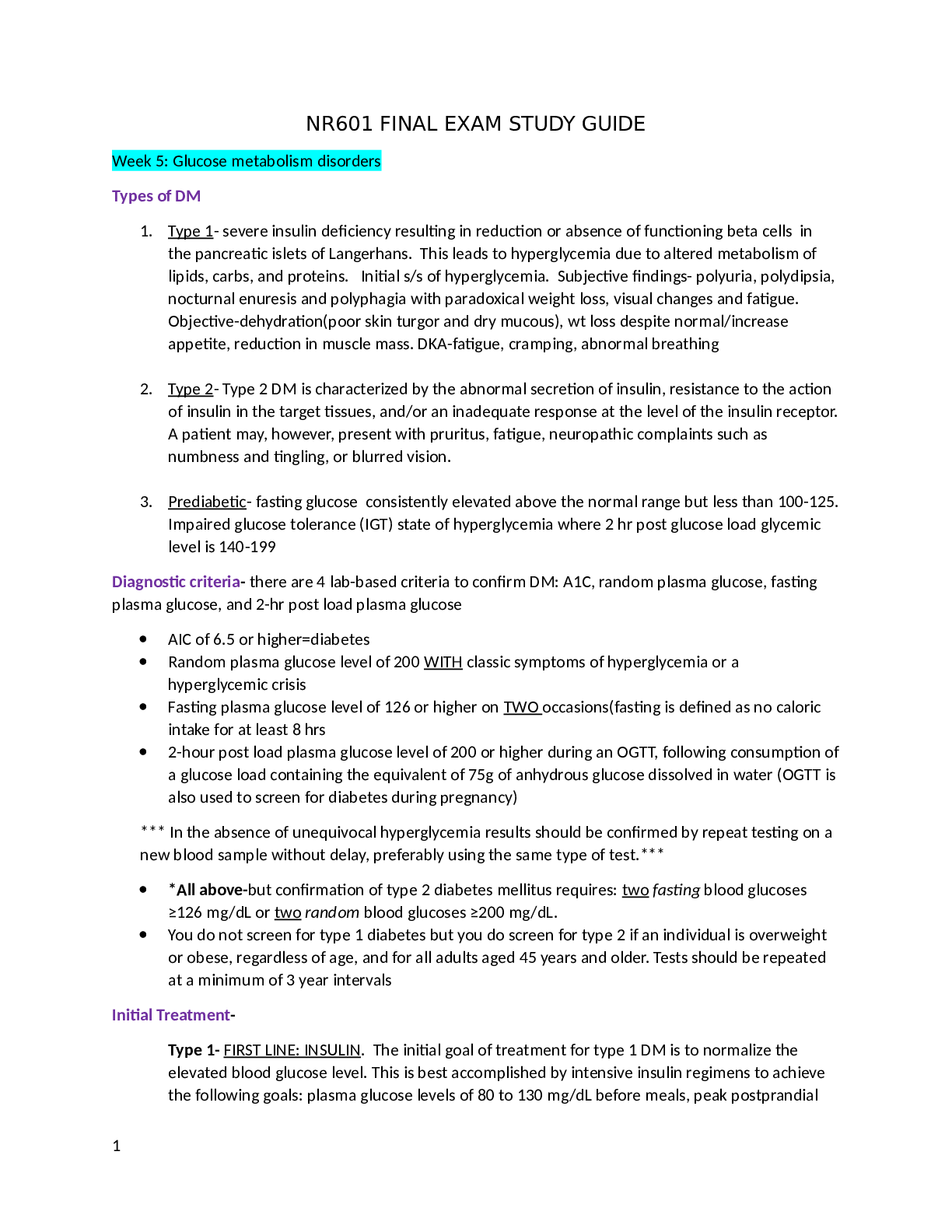
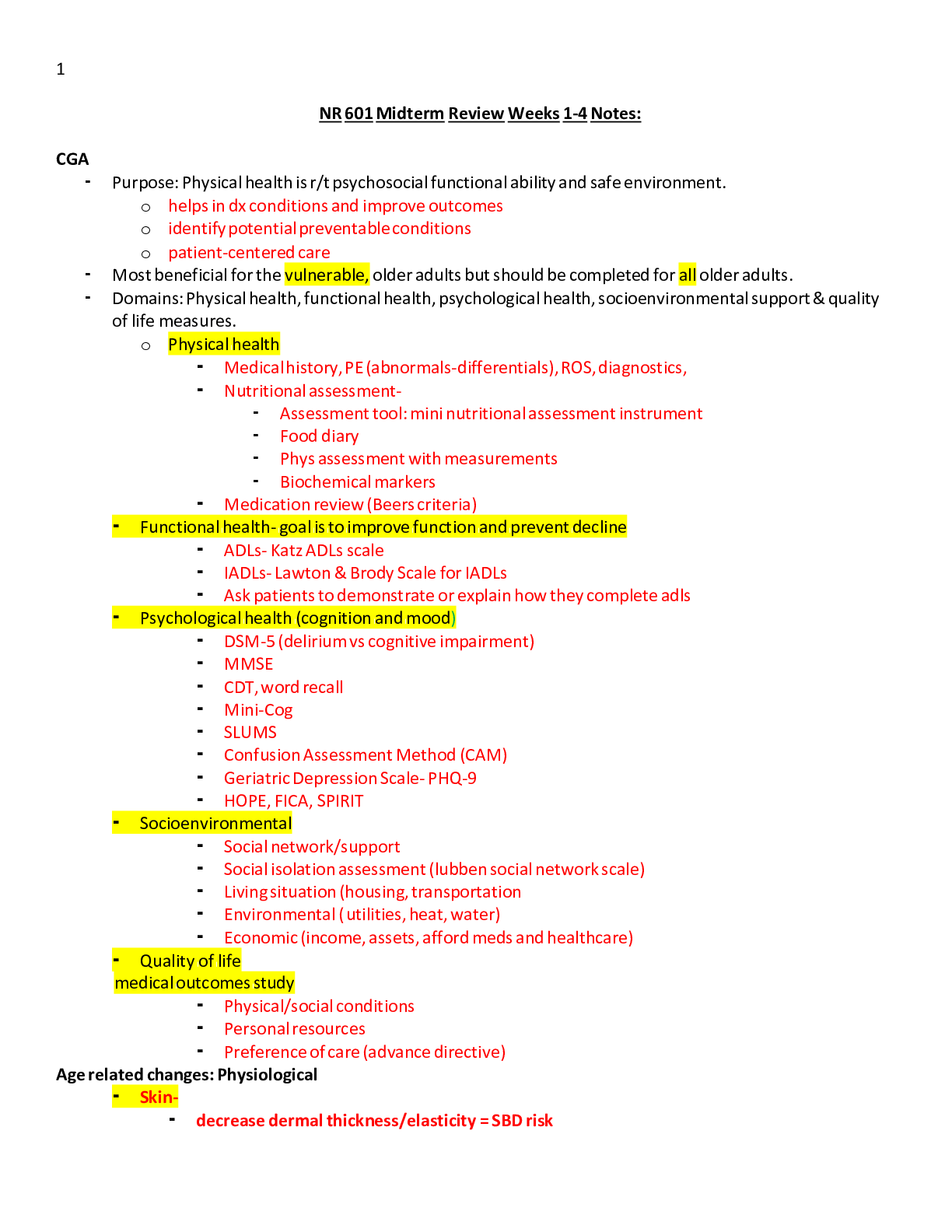
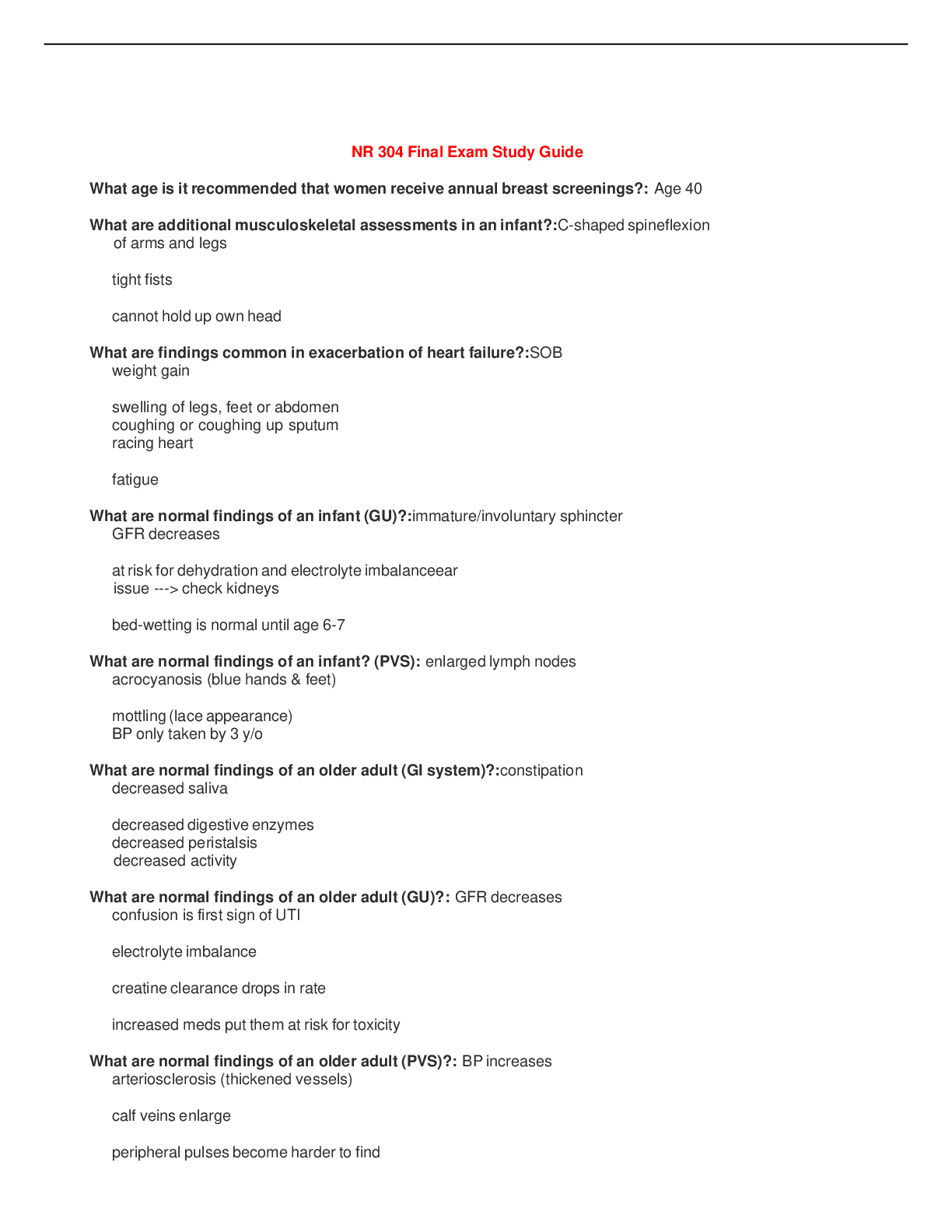
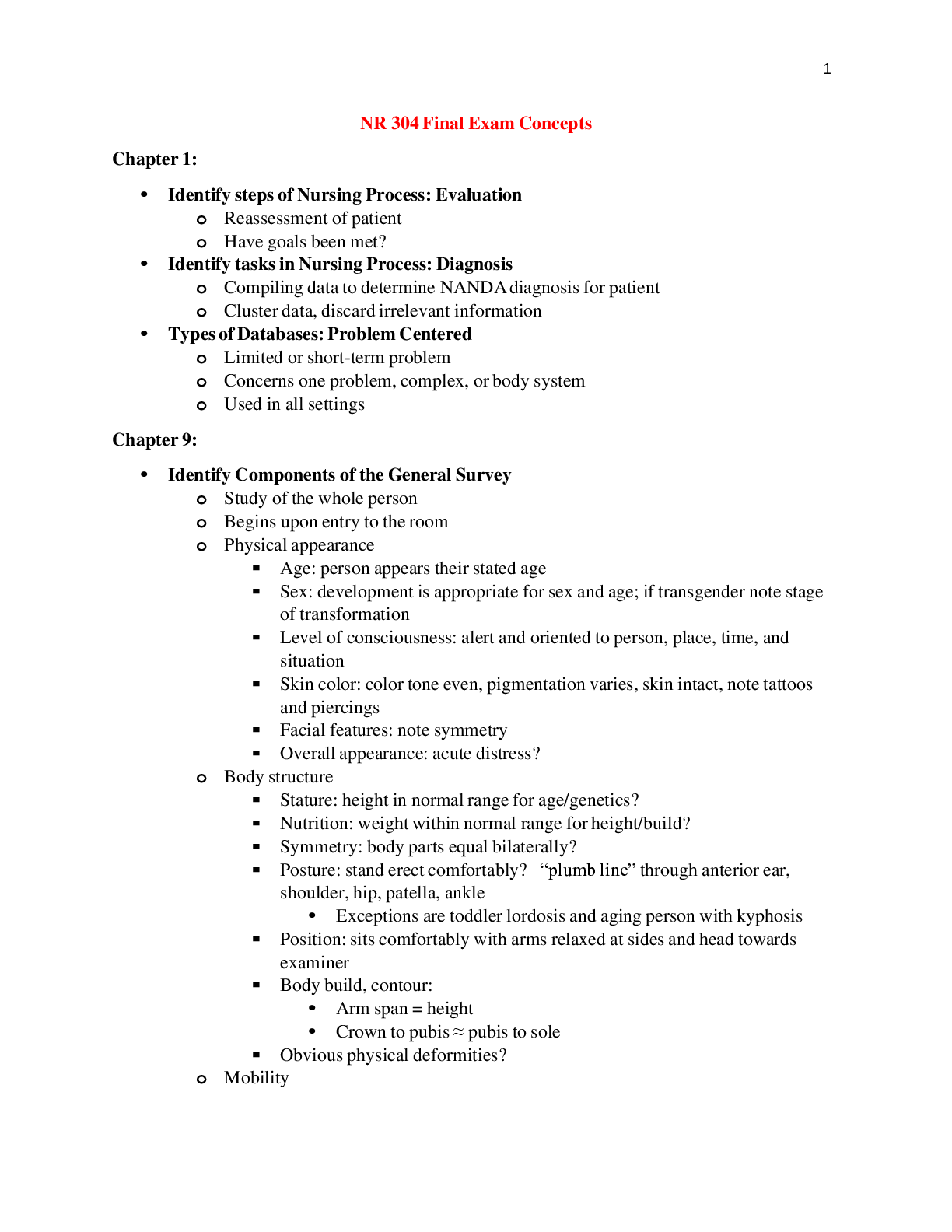
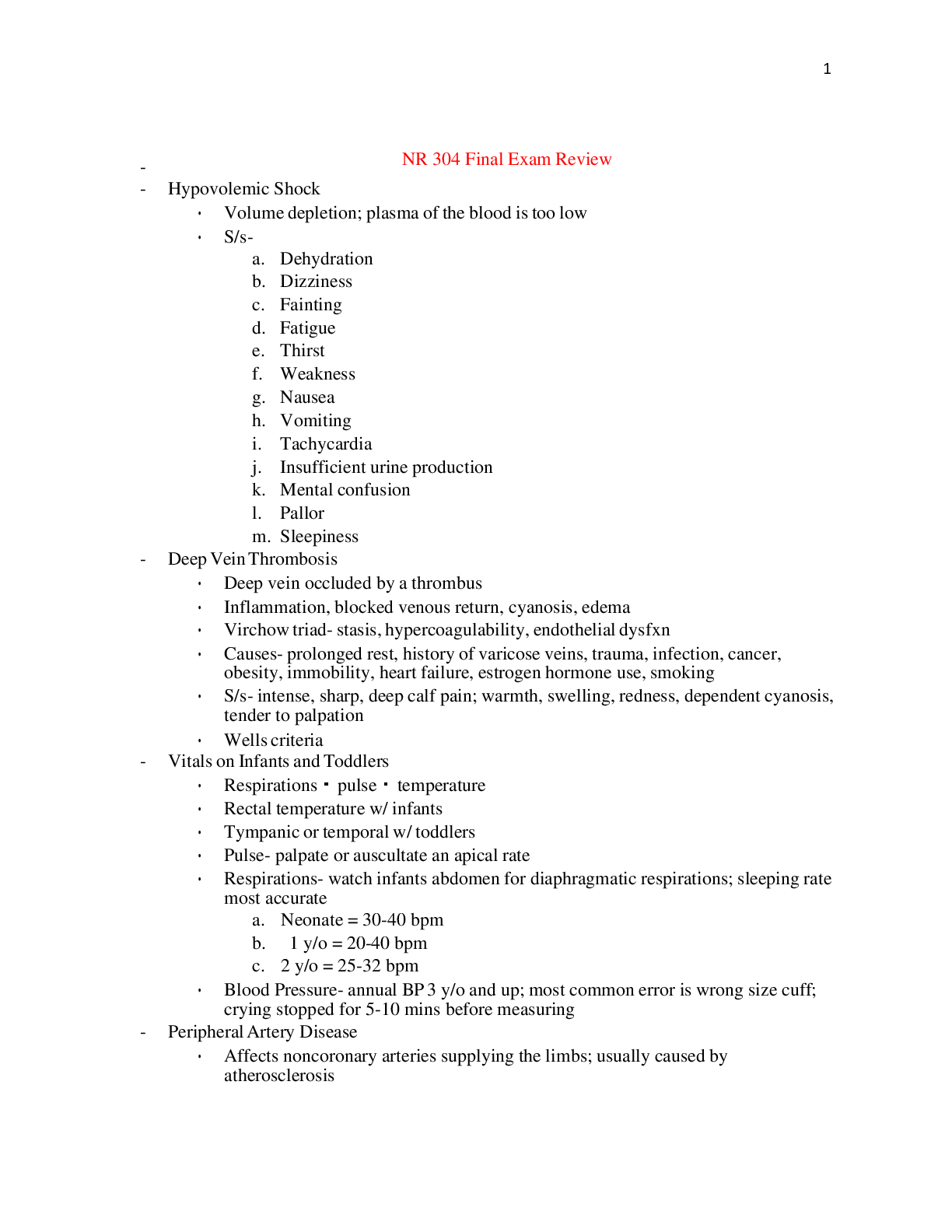
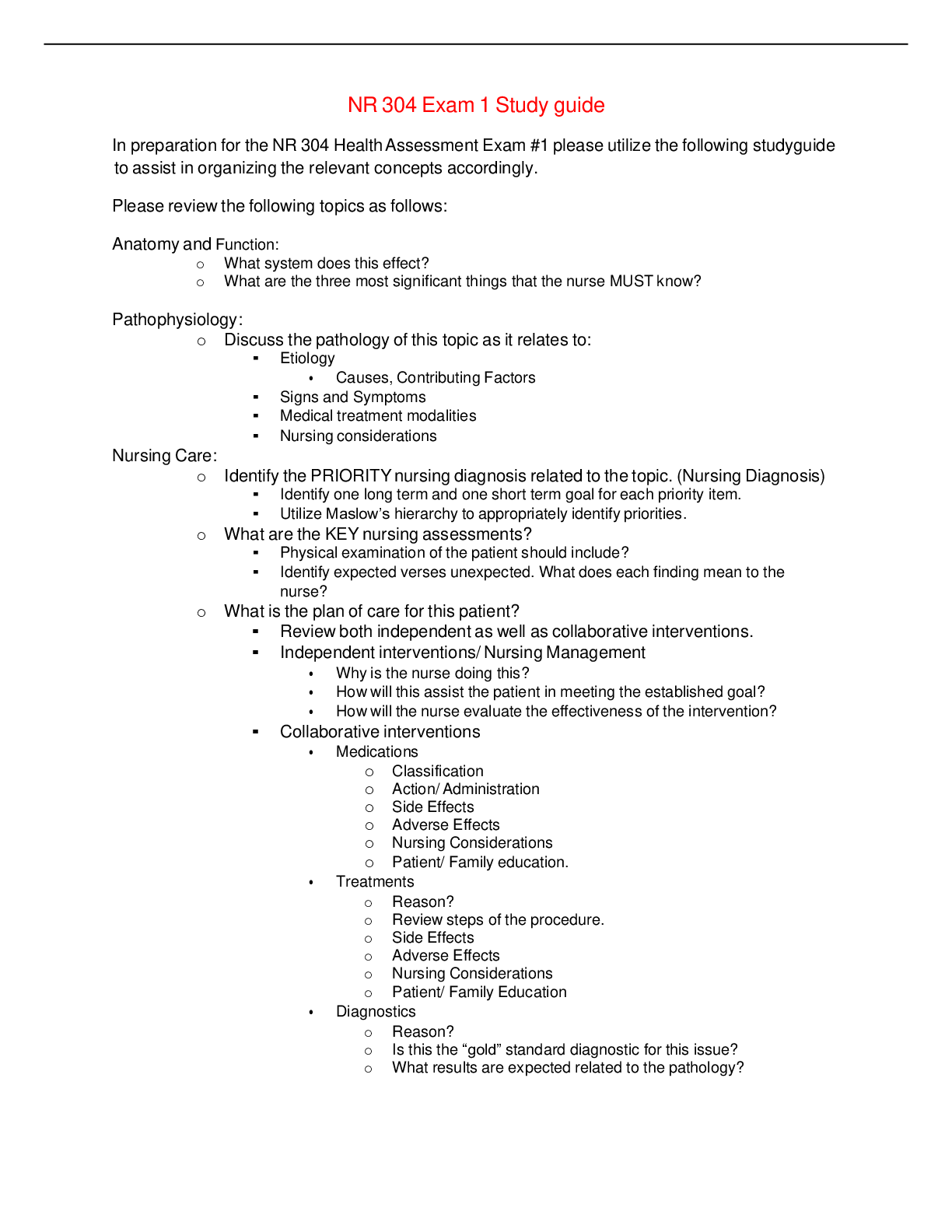

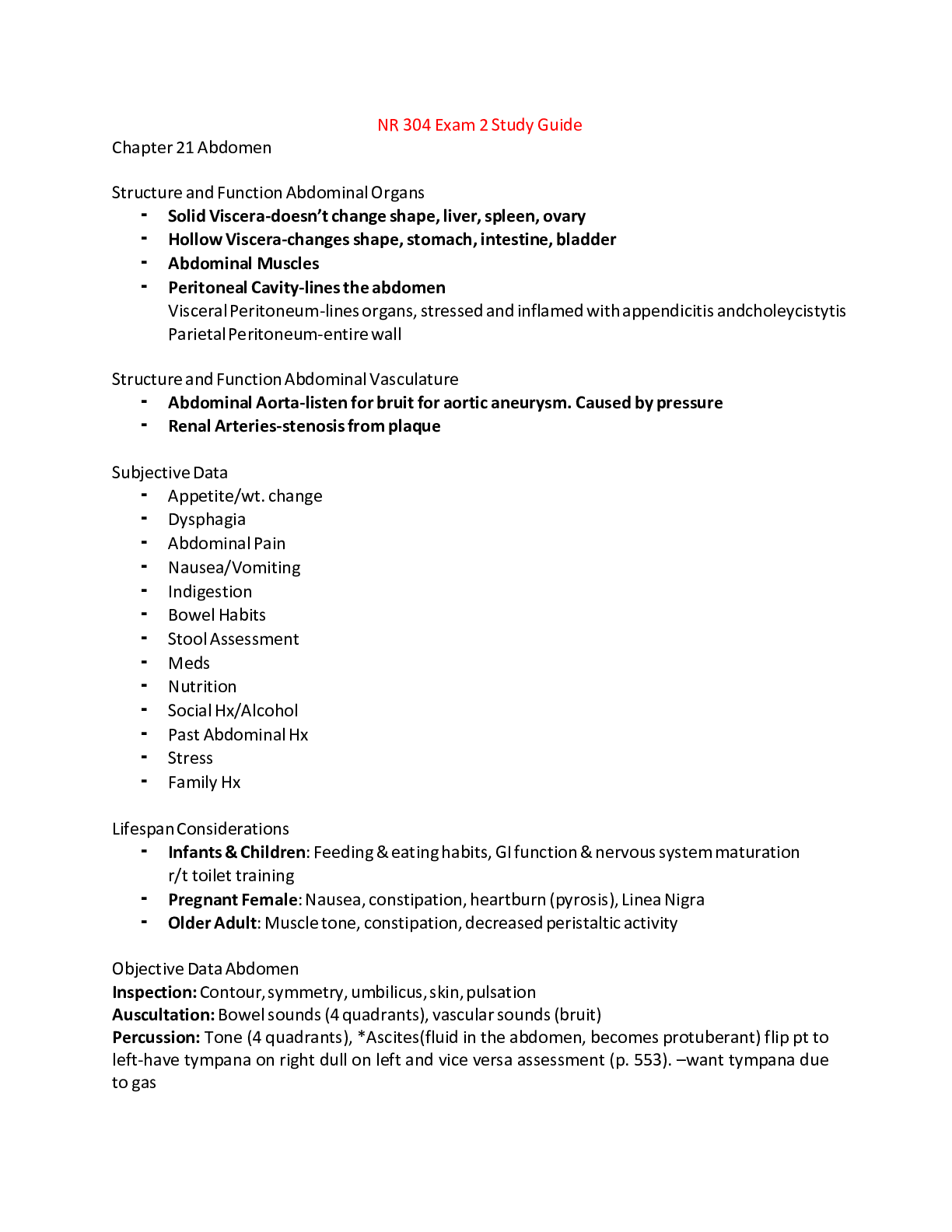
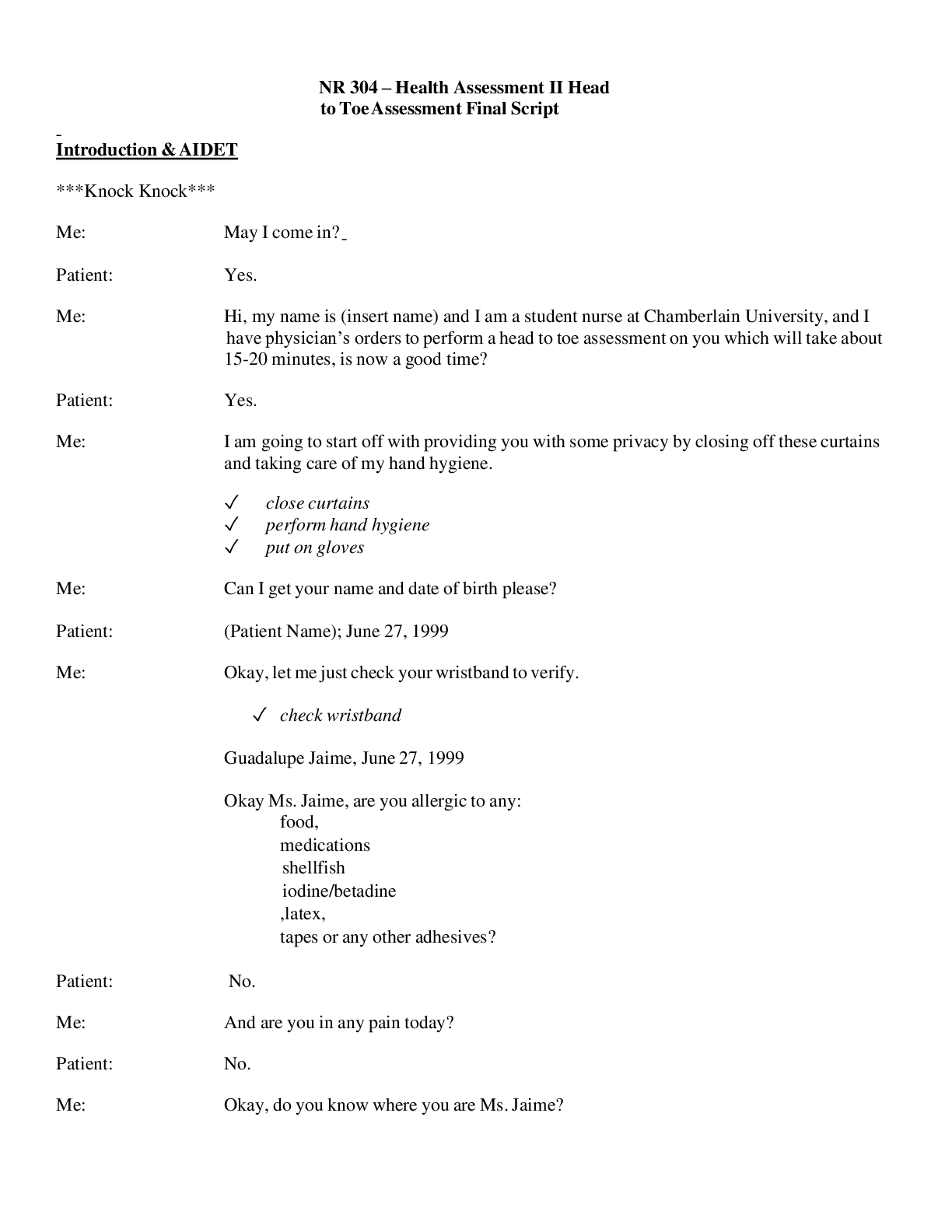
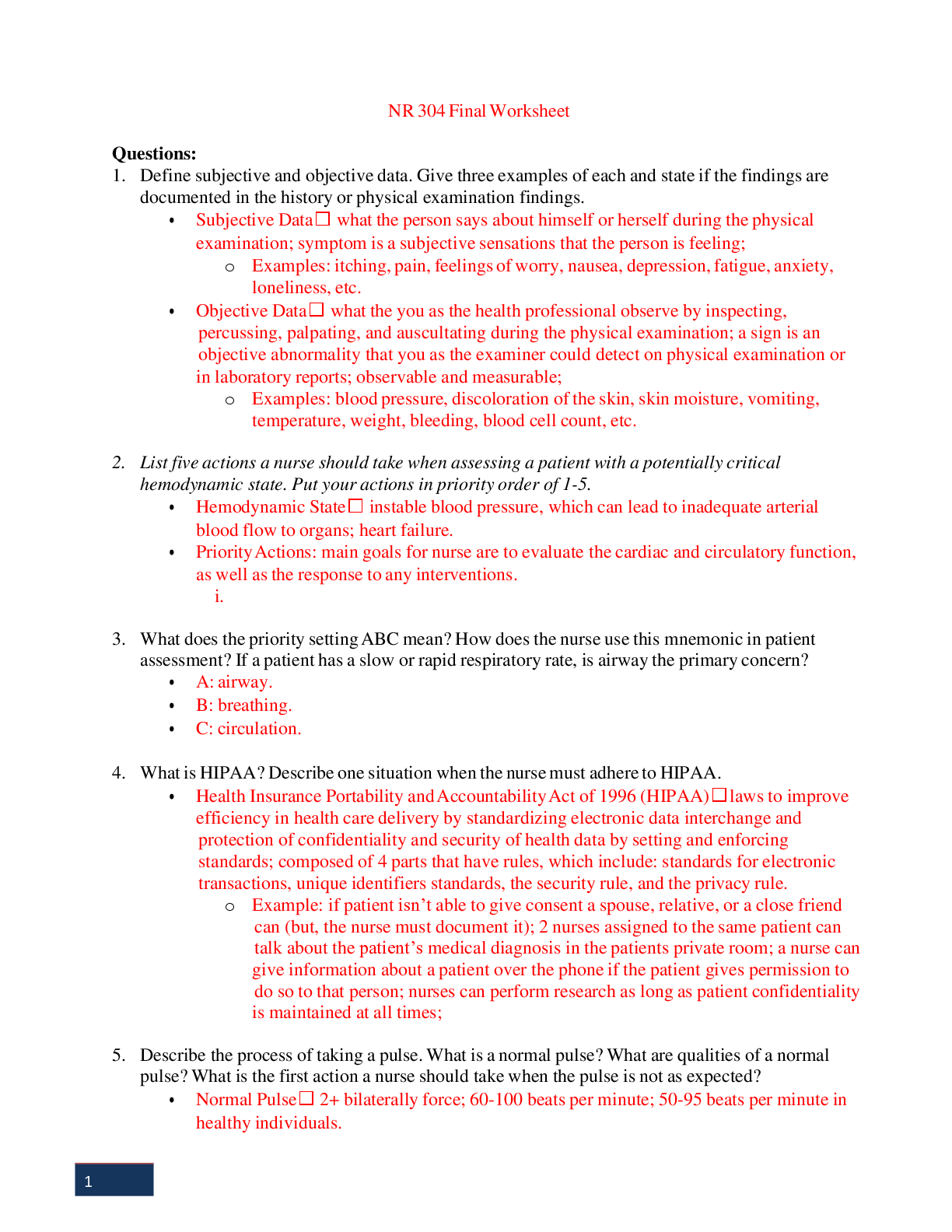
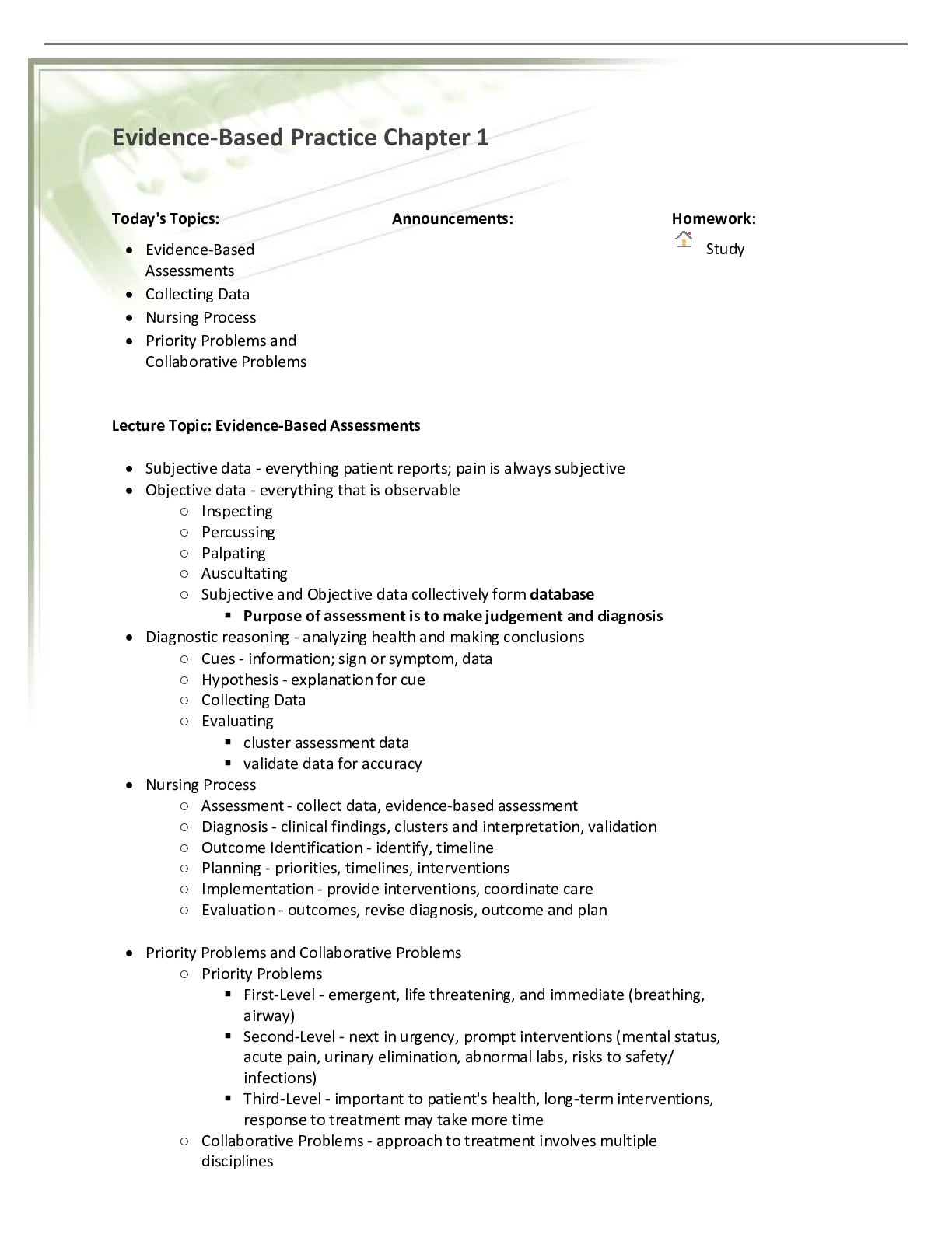
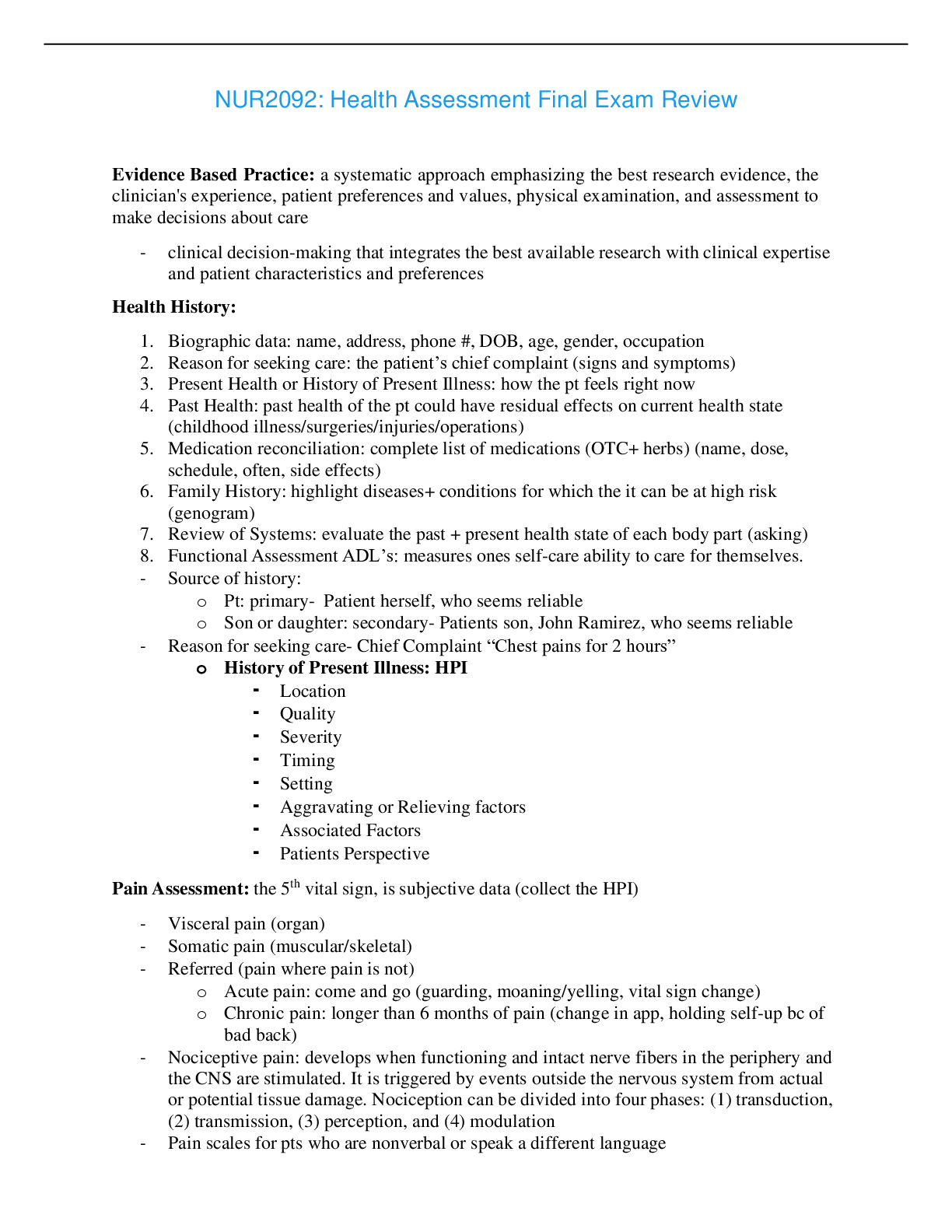
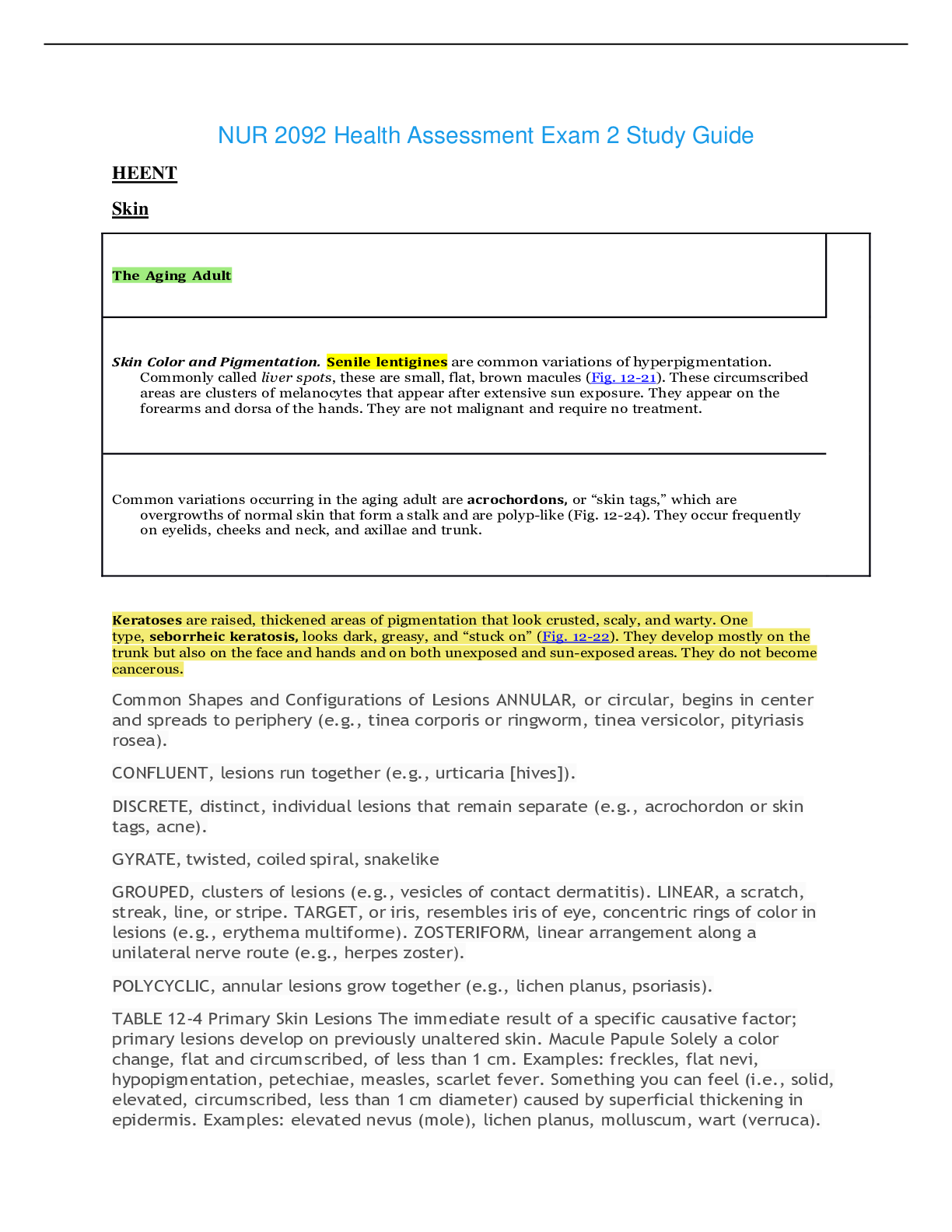




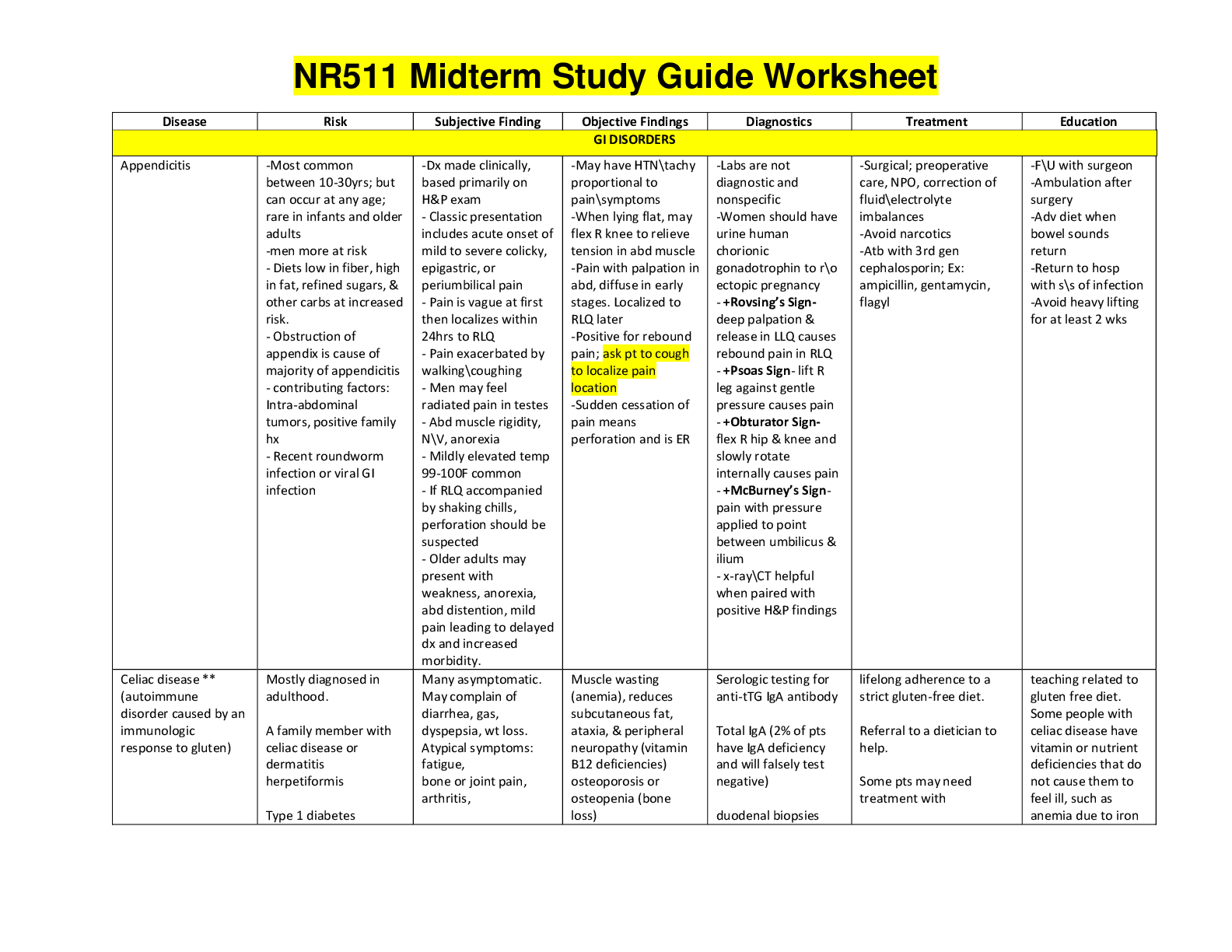
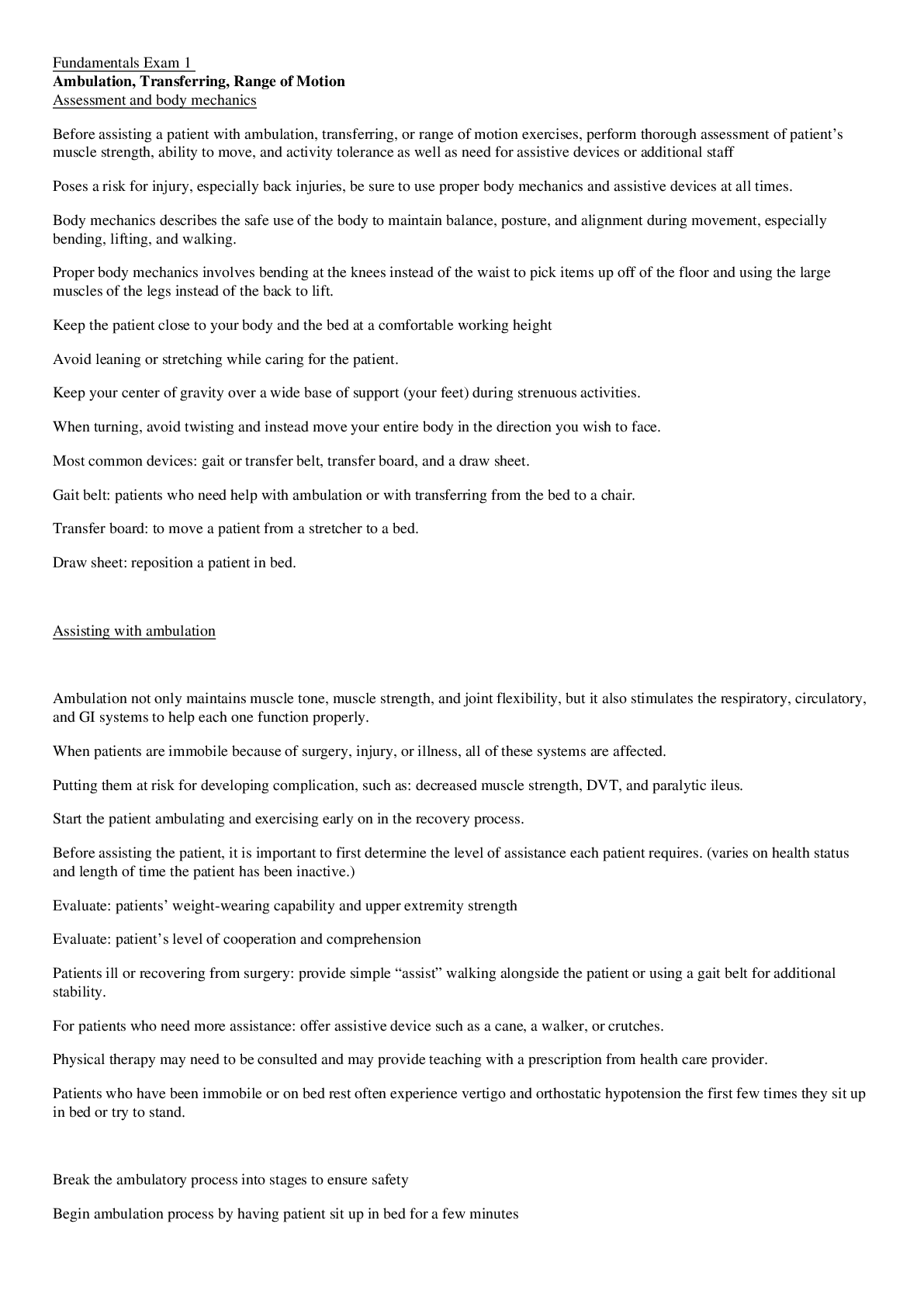
 Rasmussen College.png)
